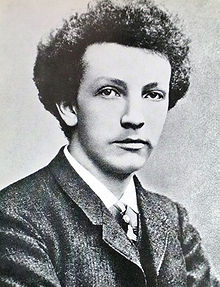In music, modernism is a philosophical and aesthetic stance underlying the period of change and development in musical language that occurred around the turn of the 20th century, a period of diverse reactions in challenging and reinterpreting older categories of music, innovations that lead to new ways of organizing and approaching harmonic, melodic, sonic, and rhythmic aspects of music, and changes in aesthetic worldviews in close relation to the larger identifiable period of modernism in the arts of the time. The operative word most associated with it is "innovation" (Metzer 2009, 3). Its leading feature is a "linguistic plurality", which is to say that no one music genre ever assumed a dominant position (Morgan 1984, 443).
Inherent within musical modernism is the conviction that music is not a static phenomenon defined by timeless truths and classical principles, but rather something which is intrinsically historical and developmental. While belief in musical progress or in the principle of innovation is not new or unique to modernism, such values are particularly important within modernist aesthetic stances.
Examples include the celebration of Arnold Schoenberg's rejection of tonality in chromatic post-tonal and twelve-tone works and Igor Stravinsky's move away from metrical rhythm (Campbell 2010, 37).
Definitions

Musicologist Carl Dahlhaus describes modernism as:
an obvious point of historical discontinuity....The "breakthrough" of Mahler, Strauss, and Debussy implies a profound historical transformation.... If we were to search for a name to convey the breakaway mood of the 1890s (a mood symbolized musically by the opening bars of Strauss's Don Juan) but without imposing a fictitious unity of style on the age, we could do worse than revert to Hermann Bahr's term "modernism" and speak of a stylistically open-ended "modernist music" extending (with some latitude) from 1890 to the beginnings of our own twentieth-century modern music in 1910. (Dahlhaus 1989, 334)
Eeri Tarasti defines musical modernism directly in terms of "the dissolution of the traditional tonality and transformation of the very foundations of tonal language, searching for new models in atonalism, polytonalism or other forms of altered tonality", which took place around the turn of the century (Tarasti 1979, 272).
Daniel Albright proposes a definition of musical modernism as, "a testing of the limits of aesthetic construction" and presents the following modernist techniques or styles (Albright 2004, 11):
- Expressionism
- New Objectivity
- Hyperrealism
- Abstractionism
- Neoclassicism
- Neobarbarism
- Futurism
- Mythic method
Periodization
Some writers regard musical modernism as an historical period extending from about 1890 to 1930, and apply the term "postmodernism" to the period after 1930 (Karolyi 1994, 135; Meyer 1994, 331â€"332).
Other writers assert that modernism is not attached to any historical period, but rather is "an attitude of the composer; a living construct that can evolve with the times" (McHard 2008, 14).
Jazz
According to jazz drummer and bandleader Kenny Clarke, bebop was initially referred to as "modern jazz" by himself and his contemporaries before it was co-opted to the name "bebop" by other writers (Du Noyer 2003, 130).
Rock music

Cultural studies professor Andrew Goodwin writes that "given the confusion of the terms, the identification of postmodern texts has ranged across an extraordinarily divergent, and incoherent profusion of textual instances ... Secondly, there are debates within popular music about pastiche and authenticity. 'Modernism' means something quite different within each of these two fields ... This confusion is obvious in an early formative attempt to understand rock music in postmodern terms" (Storey 2006, 441). Storey argues that instances of modernism in popular music are generally not cited because "it undermines the postmodern thesis of cultural fusion, in its explicit effort to preserve a bourgeois notion of Art in opposition to mainstream, 'commercial' rock and pop" (Storey 2006, 446).
Modernism in popular music had been named as early as the late 1950s when burgeoning Los Angeles rock and roll radio station KRLA started dubbing their air space "Modern Radio/Los Angeles". Author Domenic Priore believes that: "the concept of Modernism was bound up in the very construction of the Greater Los Angeles area, at a time when the city was just beginning to come into its own as an international, cultural center" (Priore 2005, 16). Some examples which soon followed include the elaborately arranged "River Deep â€" Mountain High" by Ike & Tina Turner (1966) and "Good Vibrations" by the Beach Boys (1966). Desiring "a taste of Modern, avant-garde R&B" for the latter's recording, group member and song co-writer Brian Wilson considered the music "advanced rhythm and blues", but received criticism from his bandmates, who derided the track for being "too Modern" during its making (Priore 2005, 16, 20, 48).
Art rock and progressive rock artists such as the Velvet Underground, Henry Cow, Soft Machine, and Hatfield and the North would later exhibit modernist aspirations (Storey 2006, 446), although Goodwin posits that progressive rock should be considered "anathema" to postmodernism (Storey 2006, 444).
Reception and controversy
See also
- Neoconservative postmodernism
Sources
Further reading

External links

- Audio lectures on the history of the Modern musical era by Prof. John Ronsheim
